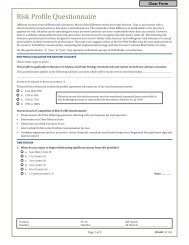The Inflation Cycle of 2002 to 2015 - Uhlmann Price Securities
The Inflation Cycle of 2002 to 2015 - Uhlmann Price Securities
The Inflation Cycle of 2002 to 2015 - Uhlmann Price Securities
Create successful ePaper yourself
Turn your PDF publications into a flip-book with our unique Google optimized e-Paper software.
Industrial Portfolio Strategy<br />
<strong>The</strong> <strong>Inflation</strong> <strong>Cycle</strong> <strong>of</strong> <strong>2002</strong> <strong>to</strong> <strong>2015</strong> ⎯ April 19, <strong>2002</strong> -57- Legg Mason Wood Walker, Inc.<br />
now that competi<strong>to</strong>rs’ currency-related advantages in market share have begun <strong>to</strong> run their course. Agricultural<br />
analyst Bill Hudson has stated that in 1900 only 5% <strong>of</strong> the world could afford fresh meat every day, by<br />
1950 the number was 20%, and <strong>to</strong>day it is about 35%. We believe that the worldwide meat intensity <strong>of</strong> use<br />
penetration rate should rise <strong>to</strong> approximately 60% <strong>to</strong> 70% by 2050, almost doubling from the current level,<br />
with global population growth added <strong>to</strong> that figure. High-value products, which include meats, are approximately<br />
two-thirds <strong>of</strong> <strong>to</strong>tal U.S. agricultural exports, and have been the lifting force for U.S. farm exports for<br />
the last two years. High-value products added $2.1 billion more than the prior year <strong>to</strong> U.S. agricultural exports<br />
<strong>of</strong> $53 billion this year, versus a $77 million decline in bulk grain exports. Currently, exports account<br />
for 10% <strong>of</strong> U.S. beef production, 7% <strong>of</strong> pork and 17% <strong>of</strong> poultry. In the 1990s alone, the grain and oilseed<br />
equivalent <strong>of</strong> U.S. meat and poultry exports has increased by about 400 million bushels, since one unit <strong>of</strong><br />
additional meat trade is equal <strong>to</strong> approximately 3.6 units <strong>of</strong> grain as feed (although poultry is less grainintensive<br />
than beef or pork).<br />
Meat stimulates feed grain consumption, but at a decreasing rate. Greater meat production efficiencies<br />
and the popularity <strong>of</strong> the less grain-intensive poultry industry have had a moderating effect on feed-grain<br />
demand, and from 1964 <strong>to</strong> 1999, the global production <strong>of</strong> meat and poultry rose by 450%, with only a 110%<br />
feed grain consumption increase. Of course, the increased share <strong>of</strong> poultry in the meat diet was a fac<strong>to</strong>r. In<br />
fact, poultry has been the star attraction <strong>of</strong> U.S. agricultural exports, with U.S. poultry export growth <strong>of</strong><br />
10.6% from 1980 <strong>to</strong> 2001, and 2001 exports <strong>of</strong> 6.2 billion pounds, or about 20% <strong>of</strong> U.S. production, with<br />
over one-half <strong>of</strong> that volume going <strong>to</strong> China and the FSU. We look for U.S. poultry exports <strong>to</strong> grow at a rate<br />
<strong>of</strong> 6.8% per year from 2001 <strong>to</strong> <strong>2015</strong>, perhaps assisted by a weaker U.S. dollar that allows for greater export<br />
cost advantage. In recent years, U.S. <strong>to</strong>tal meat exports have been hurt by animal disease concerns the world<br />
over, and economic recessions, and the USDA expects <strong>to</strong>tal U.S. meat exports <strong>to</strong> increase only 0.5% in the<br />
current fiscal year. <strong>The</strong>re are short-term impediments on the supply side. For example, if the liquidation<br />
phase <strong>of</strong> the cattle cycle were <strong>to</strong> come <strong>to</strong> a close this year, it is possible that animals bred in 2003 would not<br />
be ready for beef production until 2005, possibly restraining beef exports in the intervening period, and<br />
leading <strong>to</strong> substitution.<br />
Still, the long-term export picture is exciting if developing countries continue <strong>to</strong> embrace meat in<br />
their diets. From 1997 <strong>to</strong> 2001, Chinese beef imports rose 50% <strong>to</strong> 90,000 metric <strong>to</strong>nnes, pork imports rose<br />
206% <strong>to</strong> 450,000 metric <strong>to</strong>nnes, and poultry imports rose 31% <strong>to</strong> 1.9 MMT. Using 1995 data, if we index<br />
the U.S. <strong>to</strong> equal 1.00 and examine <strong>to</strong>tal annual meat plus fish consumption in various countries, the Japanese<br />
consume 0.81x the U.S. level, South Korea 0.74x, and China only 0.23x. Fish is less <strong>of</strong> a fac<strong>to</strong>r in the<br />
U.S. and, <strong>to</strong> the surprise <strong>of</strong> many, China. China's increasing preference for meat shows up in the substitution<br />
numbers as well. From 1990 <strong>to</strong> 2000, Chinese consumption <strong>of</strong> food grains (rice and wheat) declined<br />
13%, while China's population expanded 11%. A lack <strong>of</strong> cold s<strong>to</strong>rage and transportation infrastructure in<br />
China may restrain growth in the import <strong>of</strong> meats, but given that China has abundant labor and restrictive<br />
land and water resources, we are optimistic that China's competitive advantage will gravitate <strong>to</strong>ward laborintensive<br />
crops such as fruits, vegetables, and specialty crops rather than field crops and certain meats.<br />
U.S. Agricultural Exports and Deere S<strong>to</strong>ck<br />
<strong>The</strong> implications <strong>of</strong> greater farm industry prosperity are favorable for machinery sales, and thus<br />
Deere & Company. North American industry farm machinery inven<strong>to</strong>ries as a percentage <strong>of</strong> forward-12-<br />
month sales for 100+ horsepower, two-wheel drive (row crop) trac<strong>to</strong>rs are currently 29%, which is well be-








